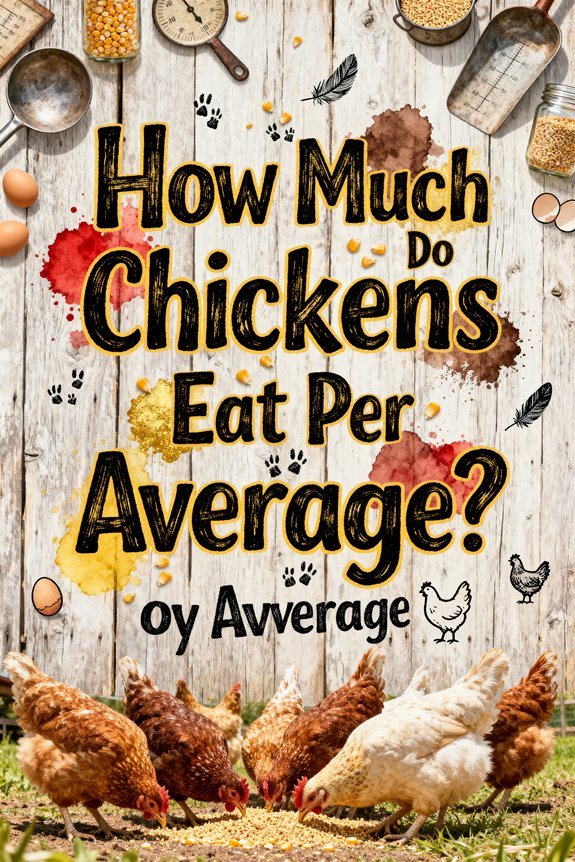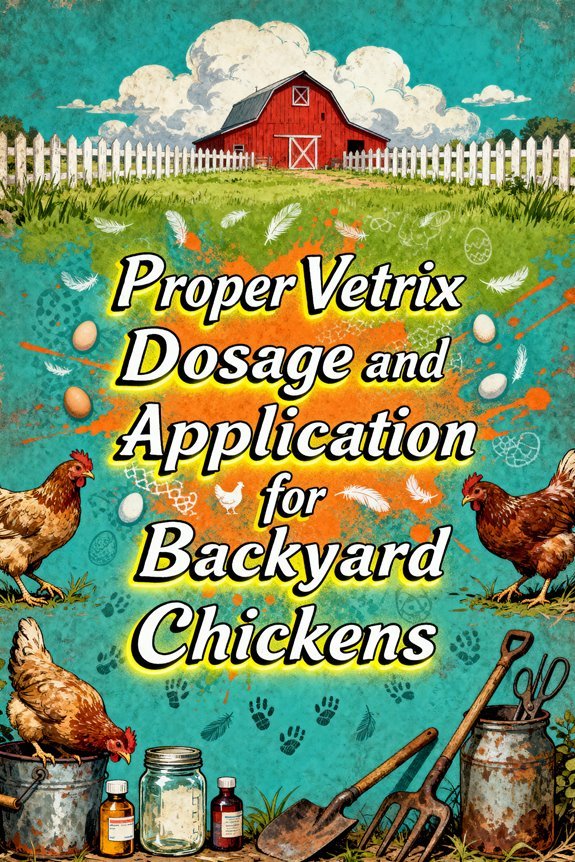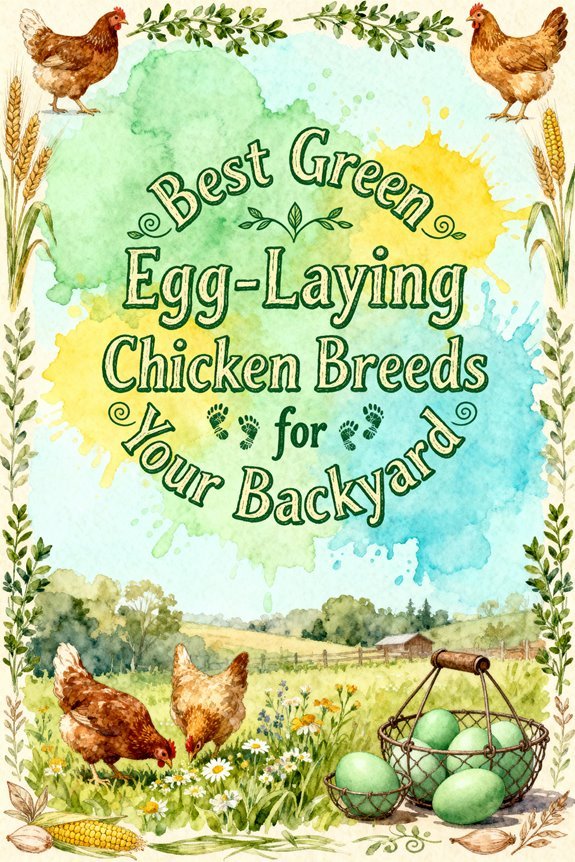How Much Do Chickens Eat Per Day on Average?
Your adult chickens will typically consume around 4 ounces (114 grams) of feed per day, though this varies based on breed and purpose. They’ll need continuous access to feed and water, drinking approximately 500ml of water daily – about twice their feed intake by weight. You’ll need to adjust portions based on factors like age, season, and whether they’re layers or meat birds. Understanding these variables guarantees ideal flock nutrition and production efficiency.
Daily Feed Requirements for Adult Chickens
Adult chickens require consistent daily feed quantities for best health and productivity. You’ll find that a fully grown chicken consumes approximately 4 ounces (¼ pound) of feed per day, which translates to 100-120 grams. The daily intake remains relatively stable, as chickens effectively self-regulate their consumption based on nutritional needs. Quality commercial feed options like Purina and Nutrena ensure proper nutrition for your flock.
Feed variations exist between different chicken types, with broilers typically consuming more than layers due to their larger size and growth requirements. You’ll need to account for these differences when planning feed quantities. A 50-pound bag of feed will sustain one adult chicken for about 7.5 months. Black oil sunflower seeds can be offered as an occasional protein-rich treat to supplement their regular feed. This consistency in feeding patterns makes it straightforward to calculate your flock’s requirements, whether you’re raising layers or meat birds. For optimal nutrition distribution, chickens should receive their daily feed in multiple smaller meals throughout the day.
Feeding Schedules and Timing
While establishing proper feeding schedules is essential for chicken health, you’ll need to implement specific timing protocols based on your birds’ life stages. You should provide continuous access to feed and water during the first 8 weeks for best chick development. After this period, you can adapt feeding frequency to match natural foraging behavior while maintaining consistent nutrition through balanced feed. Starting at about six weeks, birds should transition to a feed with 16-18% protein to support steady growth without excessive weight gain. Many chicken owners supplement their birds’ diet with dried mealworms to provide additional protein and encourage natural foraging behavior.
Consider using feed pellets for more consistent nutrition and less waste in adult birds. When changing between feed types, blend old and new feed over 1-2 weeks to prevent digestive issues. Your feeding schedule should accommodate flock hierarchy by ensuring unlimited access, as restricted feeding times can lead to competition and uneven nutrition distribution. If you’re managing a mixed-age flock, maintain all birds on grower feed until the youngest reach laying age before switching to layer feed.
Water Consumption and Its Impact on Feed Intake
Understanding your chickens’ water consumption patterns is vital since they directly impact feed intake and overall health. Adult chickens typically drink 500 ml of water daily, while young chicks consume around 150 ml. You’ll notice chickens drink 1.6 to 2.0 times more water than their feed intake by weight. Proper automatic drinkers can help ensure consistent access to water for your flock. Waterline maintenance is essential to prevent disease and support optimal flock health.
Water quality noticeably affects consumption patterns. Your flock prefers slightly acidic water with a pH between 6.0 and 6.8. Temperature effects are particularly important, as water intake increases by 7% for each degree Celsius rise in environmental temperature. During hot weather, chickens may double their water consumption to regulate body temperature. To maintain ideal feed efficiency, guarantee unlimited access to clean water, as any reduction in water availability will immediately decrease feed intake and impact production performance.
Feed Amounts for Different Age Groups
Proper feed amounts vary considerably across different chicken age groups, requiring careful attention to nutritional needs and developmental stages. Feed influences growth rates differently at each phase, with age-specific needs determining both quantity and composition. You’ll need to provide day-old chicks 1-2 ounces of high-protein starter feed daily, while growers at 7-18 weeks consume notably more at 20+ ounces per day. Layer hens typically require 4 ounces daily with increased calcium content, whereas meat birds follow a distinct pattern of 2 pounds of starter feed for the first three weeks, followed by 7 pounds of finisher feed. Understanding these requirements helps optimize nutrition delivery, as consumption patterns shift from the minimal intake of chicks to the substantial needs of mature birds. Since feed costs represent approximately 70% of raising chickens, calculating accurate daily portions helps control expenses while maintaining proper nutrition. Offering oyster shell supplements allows laying hens to self-regulate their calcium intake for optimal egg production and shell strength. Specialty breeds like Cream Legbars require similar feed amounts while producing distinctive blue-shelled eggs that add variety to egg collections.
Essential Nutrients and Feed Composition
To maintain ideal health and productivity, chickens require a precise balance of six essential nutrient categories in their feed composition. These include proteins (16-22%), carbohydrates, fats, vitamins, minerals, and water. Your feed formulation should provide metabolizable energy between 11.3-12.6 MJ/kg, with grains comprising about 70% of the mixture. Free choice feeding ensures hens can access complete layer feeds throughout the day. For optimal eggshell strength, provide crushed oyster shells as a slow-release calcium source that aids shell formation during nighttime hours.
Proper nutrient balance varies by age and purpose. Laying hens need higher calcium levels (2.5-4%) for eggshell formation, while growing chicks require increased protein (18-22%) for muscle development. Essential amino acids like lysine, methionine, and cystine must meet minimum requirements at each life stage. Brown-egg laying hens typically consume 100-105 grams per day after reaching 18 weeks of age. You’ll also need to ascertain adequate vitamin content through premixes and maintain proper mineral ratios to support peak absorption and prevent deficiencies that could compromise health and productivity.
Managing Feed Quantities for Large Flocks
Successful management of feed quantities in large flocks requires precise calculation of daily intake requirements and strategic distribution methods. You’ll need to provide 110-180g of feed per chicken daily, depending on breed size, with standard breeds consuming more than bantams. To optimize feed distribution, guarantee your feeders can accommodate several days’ worth of feed while maintaining consistent access for all birds. Choosing feeds with proper calcium levels helps maintain consistent egg production throughout the year. Just as nesting box sizes vary by breed, feed portions should be adjusted accordingly for different chicken varieties.
Understanding flock dynamics is essential when managing quantities. You’ll need to prevent competition at feeding stations by providing multiple access points, which helps lower-ranked birds maintain proper nutrition. Consider implementing automated feeding systems for larger operations, as they’ll improve consistency and reduce labor costs. During environmental changes, you’ll need to adjust quantities – increasing feed during cold weather and accounting for supplemental foraging in free-range settings. Offering wet feeds like Barastoc Top Layer Mash can help maintain proper nutrition during hot weather periods.
Seasonal Changes in Feed Consumption
When temperatures fluctuate throughout the year, your chickens’ feed consumption patterns change greatly to meet their varying metabolic demands. During cold seasons, you’ll notice increased feed intake as birds require more energy to maintain body heat, while hot weather reduces their appetite due to decreased thermoregulation needs. Using the deep litter method in coops helps naturally regulate temperatures and encourages consistent feeding patterns.
Your temperature impacts on feed consumption necessitate strategic seasonal feed adjustments. In winter, provide energy-dense feeds to support higher metabolic requirements. During summer heat, expect reduced intake but increased water consumption for cooling. Birds typically feed every 15 minutes during daylight hours, requiring consistent access to fresh feed throughout the day. Monitor feed conversion ratios closely, as they typically decline in hot weather due to physiological stress. You’ll need to adjust feeding schedules and quantities based on both seasonal daylight variations and temperature changes to maintain ideal growth and production levels year-round.
Feed Requirements by Chicken Breed Type
Different chicken breeds have distinct nutritional requirements based on their primary purpose and genetic characteristics. Broilers need high protein feeds (20-24%) during their first 4 weeks to support rapid growth and enhance feed efficiency. Layer hens require lower protein levels (16-18%) but consistent calcium intake for egg production, consuming about 0.25 pounds of feed daily. Feed must contain crushed oyster shells to provide the calcium needed for strong eggshell formation. Dual-purpose breeds maintain moderate protein needs (15-17%) to balance both meat and egg production capabilities. Meat-type roasters follow a graduated protein schedule, starting at 20-23% and decreasing to 16-18% as they mature. To achieve ideal nutritional balance, you’ll need to adjust protein percentages based on both breed type and life stage, with most chicks requiring 20-22% protein universally during their first 12 weeks. Using crumble or pellets for feeding can improve digestion and minimize waste compared to other feed forms. Setting up multiple feeders helps ensure all chickens get adequate nutrition regardless of flock hierarchy.




